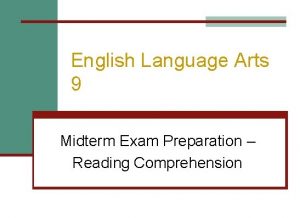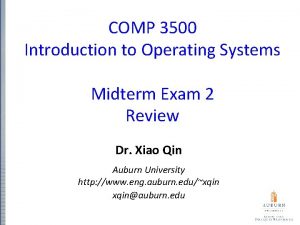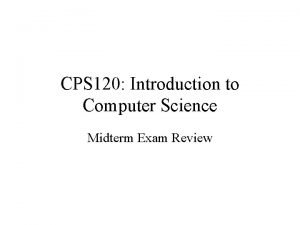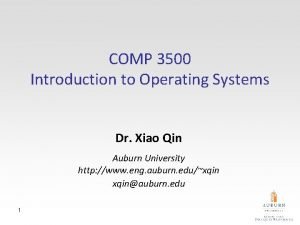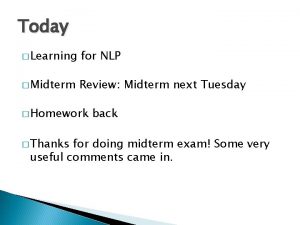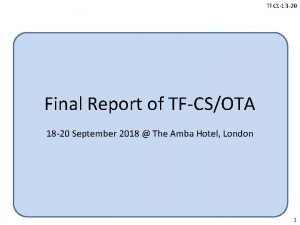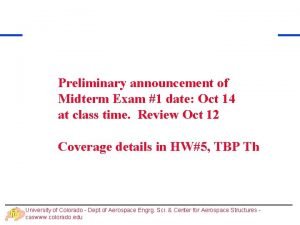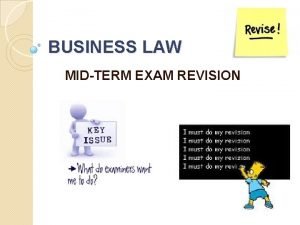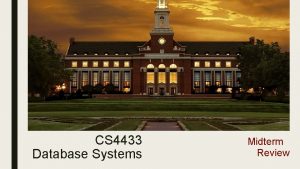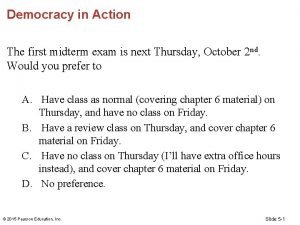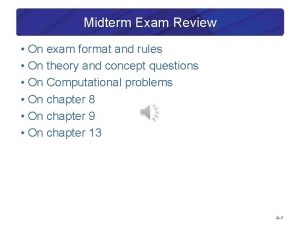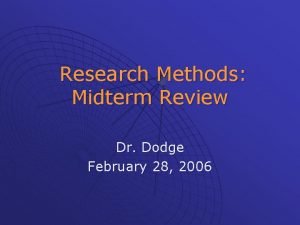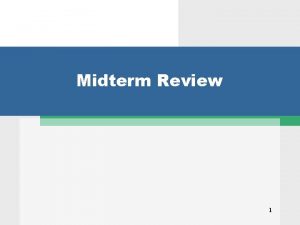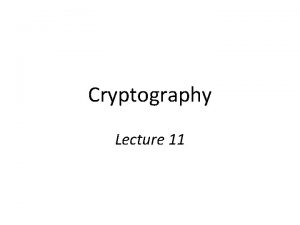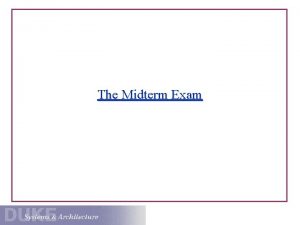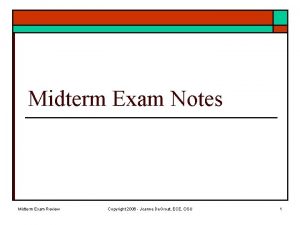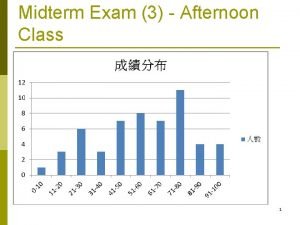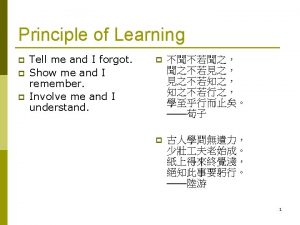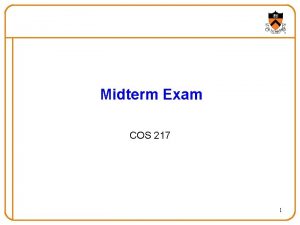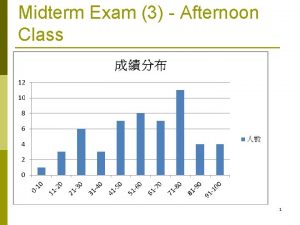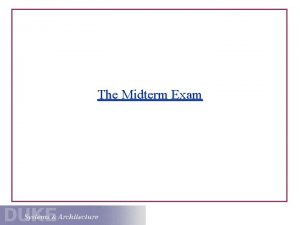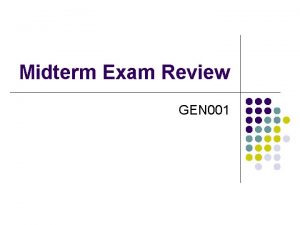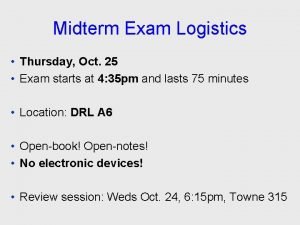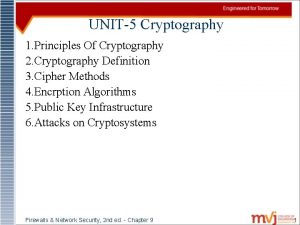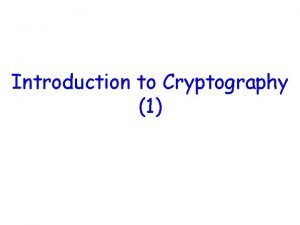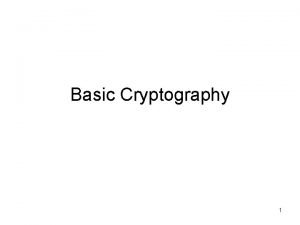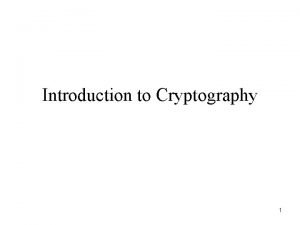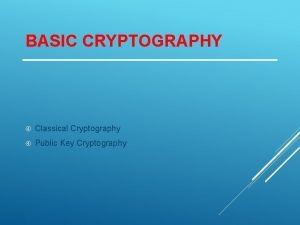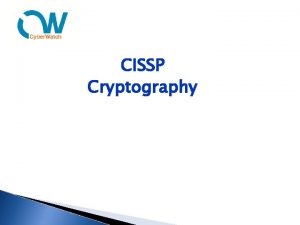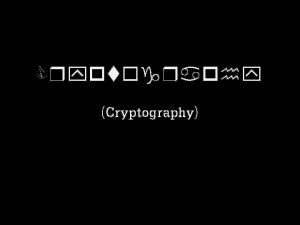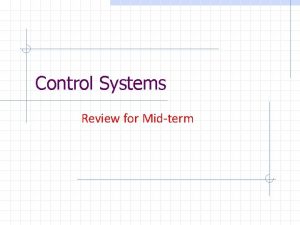Cryptography Lecture 12 Midterm exam Exam is Thursday

























- Slides: 25

Cryptography Lecture 12

Midterm exam • Exam is Thursday • Everyone in this room • Covers material up to and including last Thursday’s lecture – Including padding-oracle attacks • Open book/notes – No electronic devices • Practice midterm posted

Secure sessions

Secure sessions? • Consider parties who wish to communicate securely over the course of a session – “Securely” = secrecy and integrity – “Session” = period of time over which the parties maintain state • Use authenticated encryption…?

Enck(m 1) Enck(m 2) k Enck(m 3) k

Is this enough?

Replay attack Enck(m 1) Enck(m 2) k Enck(m 1) k

Re-ordering attack k Enck(m 1) Enck(m 2) Enck(m 1) k

Reflection attack Enck(m 1) Enck(m 2) k

Secure sessions • These attacks (and others) can be prevented using counters/sequence numbers and identifiers

Enck(“Bob”| m 1 | 1) Enck(“Bob” | m 2 | 2) k Enck(“Alice” | m 3 | 1) k

Secure sessions • These attacks (and others) can be prevented using counters and identifiers – Can also use a directionality bit in place of identifiers

Exam review

Historical schemes • Shift, Vigenere, etc. – They are all easy to attack – They are not used anymore • The point of this material was to motivate the need for a more formal treatment, and to help introduce terminology

Perfect secrecy • A more formal approach – Definitions – Proofs • Definition of perfect secrecy • The one-time pad achieves this definition • Several inherent drawbacks of perfect secrecy – The one-time pad is not used

Private-key encryption • If we want to overcome drawbacks of perfect secrecy, we must relax the definition – Computational secrecy • EAV-security – (Computational) secrecy for encryption of one message • We now need to rely on assumptions in order to prove security

Private-key encryption • Pseudorandom generators/stream ciphers – Formal definition – For now, we simply assume these exist • Pseudo-one-time pad – (Provable) EAV-security based on any PRG – Message length longer than key length – Not secure when multiple messages encrypted, or against chosen-plaintext attacks

Private-key encryption • CPA-security – Security against chosen-plaintext attacks – Requires randomized encryption! • Pseudorandom functions/block ciphers – Formal definition – For now, we simply assume these exist (e. g. , AES) • Basic encryption scheme – (Provable) CPA-security based on any PRF – 2 ciphertext expansion

Private-key encryption • Modes of encryption – CBC-mode, CTR-mode are both CPA-secure, and have ciphertext expansion of one block – Synchronous/asynchronous stream-cipher modes – These are all used extensively in the real world

Message authentication codes • Integrity as an orthogonal security concern – Secrecy and integrity are different – Encryption and message authentication are different • Message authentication codes, and definition of security • Basic MAC from any PRF – Short, fixed-length messages only

Message authentication codes • Constructing a MAC on longer messages? – Different attacks that need to be prevented • (Basic) CBC-MAC – Secure for fixed-length messages • CBC-MAC – Secure for arbitrary-length messages – Used in the real world

CCA-security • What about active attacks on encryption? – This is a real-world problem (cf. padding-oracle attacks) • CCA-security – Security against chosen-ciphertext attacks – None of the previous schemes satisfy this notion – Can achieve it with encrypt-then-authenticate

Authenticated encryption • Communication with secrecy and integrity • An AE scheme is an encryption scheme that achieves both – CCA-security – Unforgeability • Can achieve it with encrypt-then-authenticate • Other “natural” approaches do not work

Attacking encryption schemes • Let F be a block cipher • Want to leak information about some encrypted message • Fk(x) for new input x will look random! – Cause F to be evaluated on same input twice • When encrypting one message (e. g. , ECB mode) • When encrypting different messages (e. g. , HW 3) • When decrypting (e. g. , padding-oracle attack)

Attacking MACs • Need to predict the tag of some message (without requesting the tag for that message!) – Look at how verification is done • Impossible to predict the value of Fk(x) on a new input x! – Learn (information about) the value of Fk(x) by asking for tags of other messages – Set things up so that Fk(x) cancels out in verification
 American literature midterm exam
American literature midterm exam English 9 midterm exam
English 9 midterm exam Operating systems midterm
Operating systems midterm What is a midterm
What is a midterm Algebra 2 midterm study guide
Algebra 2 midterm study guide Algebra 1 midterm exam
Algebra 1 midterm exam English 1 midterm review
English 1 midterm review English 11 midterm exam
English 11 midterm exam World history semester 1 exam
World history semester 1 exam Introduction to computer science midterm exam
Introduction to computer science midterm exam Midterm exam (modules 1 - 9)
Midterm exam (modules 1 - 9) Geometry midterm exam
Geometry midterm exam Nlp midterm exam
Nlp midterm exam Grva midterm exam
Grva midterm exam Midterm exam announcement
Midterm exam announcement Business law midterm review
Business law midterm review Database systems midterm exam
Database systems midterm exam Introduction to computer science midterm exam test
Introduction to computer science midterm exam test Exam midterm
Exam midterm Data mining exam
Data mining exam Midterm exam format
Midterm exam format Research methodology midterm exam
Research methodology midterm exam Web development midterm exam
Web development midterm exam Apes midterm practice test
Apes midterm practice test Ap english language and composition midterm exam
Ap english language and composition midterm exam Ap chemistry midterm
Ap chemistry midterm

